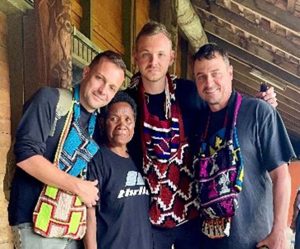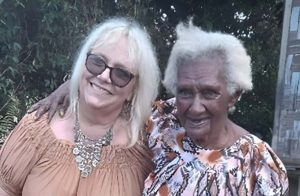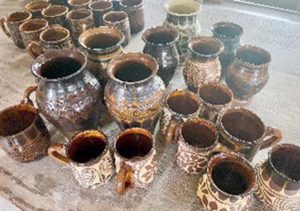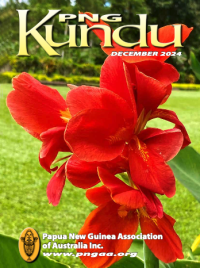Taking Muriel Home—a Mother’s Legacy
Part Two: Rosalie Everest
During my recent pilgrimage returning the ashes of my mother, Muriel Larner MBE, back to the Eastern Highlands of PNG, the most poignant moment took place around 3 am on 14 July. We were in Arau Number One village for the haus krai that began at dusk the evening before. Madong Gegesa, the widow of Gegesa Simalobe, my parents’ loyal foreman on Arau Plantation from 1957, had generously opened her small haus kapa home to accommodate me and my partner Martin along with my three adult sons, Paul, Ian and Marc. I woke to the strains of mournful singing and heart-rending wailing coming from the purpose-built haus krai about 200 metres away, where the urn of Muriel’s ashes was drawing an outpouring of boundless emotion and memory.
The main mourning song was composed in this village years ago in preparation for Misis Lana’s eventual death. The song tells a story in Arau tok ples from the point of view of a plantation worker hearing the sound of the early morning belo calling labourers to work. Its chorus repeats the names of my
sister, Bronwyn, and me. Standing alone in the cool, dark, early morning, listening on Madong’s little wooden verandah, I was transfixed. In the distance, silhouetted figures were moving against bright firelight. The villagers had been dancing, singing and weeping all night, sustained only by cups of sugary tea and, for some, the chewing of buai (betel nut). It wasn’t until dawn, when the mountain mist descended, that the dancing and crying wound down to a hush. Only then did the women go into full swing, continuing their preparations of a sumptuous mumu. Along with locally-grown garden vegetables, the key ingredient would be frozen New Zealand lamb, much of which had been provided to the village as a mark of respect by the Honourable John Boito, local MP and PNG’s Minister for Agriculture.
In the morning, we walked down to where Arau Plantation once was. The homestead is gone, having been levelled by a massive earthquake in 1993, and the once large, well-equipped coffee factory and its dams are also long gone. However, the blocks of coffee trees (planted by Wally, Muriel and Gegesa) remain and are now parcelled out to local smallholders who face the daily challenge of getting their produce over the often-boggy road to coffee-buying factories in Kainantu.

(L-R) In the foreground, Biki Kabai and Asala Kabai hold an image of their late father, Luluai Kabai, as they greet us ahead of the haus krai on 13 July 2024—Photo by Martin Cross
Still spritely at about 85, Madong proudly showed us the little Lutheran church built by her late husband, Gegesa, on what was once Arau Plantation land. Nestled amongst the coffee trees, the church continues to hold services. It was quite wonderful to see how the Gegesa family, comprised of mixed Papuan and New Guinean heritage, has integrated into Arau’s Gadsup tribal community.
Born in Daru, a young Gegesa went to Port Moresby in the early 1950s to work alongside my father, Wally Larner, at the Australian Petroleum Company. In 1957, Wally recruited the hard-working, skilled carpenter to join him on his trek up into the Highlands to establish a coffee plantation at Arau. Meanwhile, New Guinean Lutheran missionaries from Finschhafen on the Morobe Coast bravely penetrated the formidable Highland areas around Arau. Madong, the daughter of one of those Lutheran evangelists, met the dashing Papuan, Gegesa, at Arau, and they soon married. Their children, who became my childhood playmates, have settled with their families at Arau or Kainantu.
My sons were amazed to see old photographs of themselves as children pasted onto placards and held aloft by a throng of villagers who met us on our arrival with welcome songs, heartfelt speeches and a generous bilum presentation. They then watched a dramatic re-enactment of village folklore depicting their grandparents, Wally and Muriel, and Gegesa being greeted for the first time by the late chief Luluai Kabai at Arau village.
The descendants of Luluai Kabai welcomed Martin and me warmly, giving us a tour of the village. I revisited the site of the late chief’s original haus kunai where I have a vivid memory of my parents, my sister and me paying our respects one night in the early 1960s when Kabai lay dying on his bed. He was the last luluai of Arau. One of his sons, Biki, showed us a very large saucepan that Wally gave Kabai in 1957. He said the handles broke off years ago but he still uses it and thinks of Masta Wally. Biki also pointed out the rows of healthy coffee trees growing in the Kabai compound and explained how they were grown from seedlings given to Luluai Kabai by Wally and Muriel years ago.

At dawn on 14 July, inside the haus krai after an all-night (tudak inap long tulait) vigil for Misis Lana. The mourners are feeling drained and trying to keep warm by the fire grate with the urn of Muriel’s ashes nearby—Photo by Martin Cross
Before we drove back to Kainantu with Muriel’s ashes for the final interment scheduled for the next day, the Arau village women handed me a bunch of exquisite heliconia blooms. They were a memento of Arau village to be buried with Misis Lana’s remains in her final resting place alongside Masta Wally in Kainantu. As a keen gardener and passionate lover of flowers, my mother would have been delighted.
On Monday, 15 July, a memorial service was held at the Eastern Highlands Cultural Centre (EHCC), founded by Muriel in Kainantu town and officially opened in November 1981. The memorial service, which was truly moving, was organised by the Centre’s director, Johnson Puma, and the new Manager of KKB Enterprises in Kainantu, Dorothy Keari, a successful businesswoman, who used to model Muriel’s silk-screen creations in fashion parades in the 1970s. Enabled by a Memorandum of Understanding between the Eastern Highlands Provincial Government and KKB, Dorothy has recently been given broad managerial oversight of the Centre, Dorothy told me that, as a teenager in Kainantu, she was greatly inspired and encouraged by my mother. How proud would Muriel be to know that one of her young female protégés would one day become a significant business leader in the Kainantu community and oversee her precious EHCC! Following speeches by local dignitaries and a prayer by former Salvation Army Pastor Kafero, I was asked to speak on behalf of Muriel’s family. Links to YouTube videos of the occasion are included at the end of this article.
After the formalities of the memorial service concluded, Muriel’s ashes were carried around the Centre with such gentle reverence by two of her original loyal potters who had known and worked with her—Abaka and Remy. They wanted her to say a last goodbye to all the different parts of the amazing enterprise she had created but sadly left behind. Some of the original potters and weavers who still work at EHCC shared with me their deep gratitude for the impact that my mother had on their lives, providing them with special skills and the means of earning an income for their families.

Abaka, left, and Remy, second from the right, carry Muriel’s urn in a farewell tour of the Centre. As a traditional expression of mourning, many were daubed in clay on their skin and clothing—Photo by Martin Cross
We took Muriel’s ashes to the Kainantu cemetery to be buried alongside Wally’s grave. Despite relocating to Australia to be closer to family and medical assistance in her later years, Muriel always felt that she was a Papua New Guinean. Right up to her last breath, she maintained a deep interest in and affection for the people and the arts of the land of her birth.
Following Wally’s passing in 1967, Muriel was left a young widow with two small daughters and a coffee plantation to run. Her contribution to the coffee industry, her advocacy for the disabled, her concern for the lives of ordinary Papua New Guineans, and her passion for developing the arts in PNG are truly remarkable legacies that she left behind.
My family is very proud of Muriel’s achievements. We are at peace knowing that she lies in her husband’s arms, surrounded by a loving community stretching from Kainantu town to Arau village.
Vale Mim/Muriel/Misis Lana who was born in Rabaul on 6 September 1929 and died in Queensland on 18 April 2019.

(L-R) Ian, Marc and Paul Everest with Ihi, granddaughter of the late Luluai Kabai who devotedly helped to rear these young men when they were growing up—Photograph by Rosalie Everest on 15 July 2024
YouTube video links were provided with permission from the Everest family. Grateful acknowledgments go to videographer Malum Nalu. The viewer may see links to Malum’s ‘Muriel Larner playlist’ of six videos:




